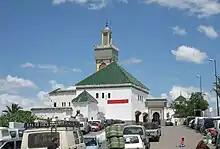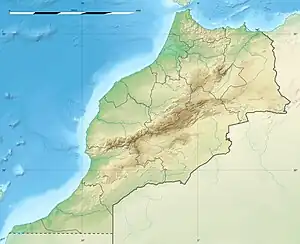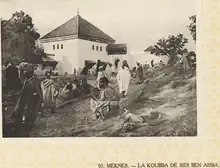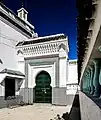| Cheikh Al Kamel Mausoleum | |
|---|---|
Arabic: ضريح الشيخ الكامل | |
 | |
| Religion | |
| Affiliation | Islam |
| District | Bab al-Jadid |
| Region | Fès-Meknès |
| Status | Active |
| Location | |
| Location | Meknes, Morocco |
| Country | Morocco |
 Location in Morocco | |
| Geographic coordinates | 33°53′56″N 5°34′14″W / 33.8987900°N 5.5705515°W |
| Architecture | |
| Type | mausoleum, zawiya and mosque |
| Style | Moroccan |
| Creator | Mohammed ben Abdallah |
| Date established | 16th century |
| Completed | 1776 |
| Specifications | |
| Minaret(s) | 1 |
| Shrine(s) | 1 |
The Shaykh al-Kamil Mausoleum (Arabic: ضريح الشيخ الكامل), romanized as Cheikh Al Kamel Mausoleum also known as the Mausoleum of al-Hadi ben Issa (ضريح الهادي بنعيسى) is a historic religious complex located in Meknes, Morocco.[1]
It consists of a zawiya, mosque, and the mausoleum of Mohammed al-Hadi ben Issa the founder of the Isawiyya order of Sufism.[1]
History

The mausoleum of Mohamed ben Issa, a prominent Ash'ari scholar and Sufi mystic, was established in the 16th century.[2] Later in 1776, the Alaouite ruler, Mohammed Ben Abdallah, built a completely new structure around the saint's tomb.[3] The minaret appears to have been a later addition. The complex is currently used as both a mosque and mausoleum.[4]
Usage
Mawlid Celebration
The celebration of Mawlid, which is the celebration of the birth of the Prophet Muhammad, occurs at the mausoleum.[5] This festival is different from other Mawlids, due to it being done in the unique Issawi style.[5] Instruments like the ta'raj, the brass, the flutes, the drums, the trumpet, are played, before the participants enter a long session of dhikr and meditation.[5] Traditionally, dates are a meal during this festive occasion.[5]
Rituals
The rituals of the Issawi order are performed here.[6] The mausoleum is also the focal point of an annual moussem (a type of Sufi religious festival).[6] Unlike Mawlid, the festival here was brutal in nature, and it was historically known for its displays of self-mutilation.[6] The religious rituals in the festival are intertwined with musical and joyful celebrations that are sometimes violent, including rolling around and drinking blood of animal sacrifices.[7]
Controversy
The mausoleum became known for its presence of homosexuals, and the government tried to suppress the rising of homosexual rituals within the building.[8] These homosexuals claimed to have been the descendants of Aisha, another local patron saint of Meknes.[8]
Gallery
 The entrance to the mausoleum
The entrance to the mausoleum The courtyard of the building, covered by glass roof
The courtyard of the building, covered by glass roof Doorway and entrance to the prayer hall
Doorway and entrance to the prayer hall The tomb of one of Mohammed Al-Hadi ben Issa's descendants
The tomb of one of Mohammed Al-Hadi ben Issa's descendants Hallway
Hallway Several graves of commoners, behind the mausoleum
Several graves of commoners, behind the mausoleum
See also
References
- 1 2 "El Hadi Ben Aïssa : Le symbole de la délivrance". Aujourd'hui le Maroc (in French). Retrieved 2020-11-30.
- ↑ "ضريح الشيخ الكامل وجهة مريدي الزوايا - جريدة الصباح". assabah.ma (in Arabic). 2011-02-18. Retrieved 2020-11-30.
- ↑ Aouchar, Amina (2005). Fès, Meknès (in French). Flammarion. p. 65. ISBN 9782080108418.
- ↑ "El Hadi Ben Aïssa : Le symbole de la délivrance". Aujourd'hui le Maroc (in French). Retrieved 2020-11-30.
- 1 2 3 4 ناصر, هشام. "مكناس.. الطوائف العيساوية تضفي طابعا احتفاليا فريدا بمناسبة ذكرى عيد المولد النبوي". الكاتب (in Arabic). Retrieved 2023-12-20.
- 1 2 3 Funck-Brentano, C. (1987) [1934]. "Meknes". E.J. Brill's first encyclopaedia of Islam, 1913-1936. Vol. 5. Leiden ; New York : E.J. Brill. p. 456. ISBN 978-90-04-08265-6.
- ↑ "مكناس تتحول إلى"كعبة" الطوائف العيساوية في عيد المولد النبوي || ANFASPRESS - أنفاس بريس جريدة إلكترونية مغربية - جريدة إلكترونية مغربية تجدد على مدار الساعة - المغرب - ANFAS PRESS ( Ariri Abderrahim )". web.archive.org. 2020-10-30. Retrieved 2023-12-20.
- 1 2 "طقوس غريبة توقظ "الشيخ الكامل" .. و"جذبة عيساوة" تطرد الجن". Hespress - هسبريس جريدة إلكترونية مغربية (in Arabic). 2018-11-21. Retrieved 2023-12-20.